|
|
||
|---|---|---|
| arc | ||
| cleave | ||
| edit | ||
| enumerate | ||
| html | ||
| sandbox | ||
| tangle | ||
| termbox | ||
| .travis.yml | ||
| 000organization.cc | ||
| 001help.cc | ||
| 002test.cc | ||
| 003trace.cc | ||
| 003trace.test.cc | ||
| 010vm.cc | ||
| 011load.cc | ||
| 012transform.cc | ||
| 013update_operation.cc | ||
| 014literal_string.cc | ||
| 015literal_noninteger.cc | ||
| 016dilated_reagent.cc | ||
| 017parse_tree.cc | ||
| 018type_abbreviations.cc | ||
| 020run.cc | ||
| 021check_instruction.cc | ||
| 022arithmetic.cc | ||
| 023boolean.cc | ||
| 024jump.cc | ||
| 025compare.cc | ||
| 026call.cc | ||
| 027call_ingredient.cc | ||
| 028call_reply.cc | ||
| 029tools.cc | ||
| 030container.cc | ||
| 031merge.cc | ||
| 032array.cc | ||
| 033exclusive_container.cc | ||
| 034address.cc | ||
| 035lookup.cc | ||
| 036refcount.cc | ||
| 037abandon.cc | ||
| 038new_text.cc | ||
| 039location_array.cc | ||
| 040brace.cc | ||
| 041jump_target.cc | ||
| 042name.cc | ||
| 043space.cc | ||
| 044space_surround.cc | ||
| 045closure_name.cc | ||
| 046global.cc | ||
| 047check_type_by_name.cc | ||
| 050scenario.cc | ||
| 051scenario_test.mu | ||
| 052tangle.cc | ||
| 053recipe_header.cc | ||
| 054static_dispatch.cc | ||
| 055shape_shifting_container.cc | ||
| 056shape_shifting_recipe.cc | ||
| 057immutable.cc | ||
| 058to_text.cc | ||
| 059to_text.mu | ||
| 060rewrite_literal_string.cc | ||
| 061text.mu | ||
| 062convert_ingredients_to_text.cc | ||
| 063array.mu | ||
| 064list.mu | ||
| 065duplex_list.mu | ||
| 066stream.mu | ||
| 067random.cc | ||
| 068random.mu | ||
| 069hash.cc | ||
| 070table.mu | ||
| 071recipe.cc | ||
| 072scheduler.cc | ||
| 073wait.cc | ||
| 074deep_copy.cc | ||
| 075channel.mu | ||
| 080display.cc | ||
| 081print.mu | ||
| 082scenario_screen.cc | ||
| 083scenario_screen_test.mu | ||
| 084console.mu | ||
| 085scenario_console.cc | ||
| 086scenario_console_test.mu | ||
| 087file.cc | ||
| 088file.mu | ||
| 089scenario_filesystem.cc | ||
| 090scenario_filesystem_test.mu | ||
| 091socket.cc | ||
| 092socket.mu | ||
| 100trace_browser.cc | ||
| 101run_sandboxed.cc | ||
| 102persist.cc | ||
| 998check_type_pointers.cc | ||
| 999spaces.cc | ||
| Readme.md | ||
| build | ||
| build_and_test_until | ||
| cannot_write_tests_for | ||
| channel.mu | ||
| chessboard.mu | ||
| clean | ||
| console.mu | ||
| counters.mu | ||
| display.mu | ||
| example1.mu | ||
| exuberant_ctags_rc | ||
| factorial.mu | ||
| filesystem.mu | ||
| fork.mu | ||
| git_log_filtered | ||
| global.mu | ||
| immutable-error.mu | ||
| index.html | ||
| lambda-to-mu.mu | ||
| mu | ||
| mu.vim | ||
| mutable.mu | ||
| new_lesson | ||
| nqueens.mu | ||
| real-files.mu | ||
| relayout | ||
| screen.mu | ||
| server-socket.mu | ||
| static-dispatch.mu | ||
| tangle.mu | ||
| test_layers | ||
| update_html | ||
| vimrc.vim | ||
| x.mu | ||
Readme.md
Mu explores ways to turn arbitrary manual tests into reproducible automated tests. Hoped-for benefits:
-
Projects release with confidence without requiring manual QA or causing regressions for their users.
-
Open source projects become easier for outsiders to comprehend, since they can more confidently try out changes with the knowledge that they'll get rapid feedback if they break something. Projects also become more rewrite-friendly for insiders: it's easier to leave your project's historical accidents and other baggage behind if you can be confident of not causing regressions.
-
It becomes easier to teach programming by emphasizing tests far earlier than we do today.
In this quest, Mu is currently experimenting with the following mechanisms:
-
New, testable interfaces for the operating system. Currently manual tests are hard to automate because a file you assumed might vanish, the network might go down, etc. To make manual tests reproducible it suffices to improve the 15 or so OS syscalls through which a computer talks to the outside world. We have to allow programs to transparently write to a fake screen, read from a fake disk/network, etc. In Mu, printing to screen explicitly takes a screen object, so it can be called on the real screen, or on a fake screen inside tests, so that we can then check the expected state of the screen at the end of a test. Here's a test for a little text-mode chessboard program in Mu (delimiting the edge of the 'screen' with dots):
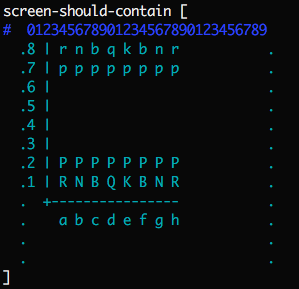
I'm building up similarly dependency-injected interfaces to the keyboard, mouse, touch screen, disk, network, etc.
-
Support for testing side-effects like performance, deadlock-freedom, race-freeness, memory usage, etc. Mu's white-box tests can check not just the results of a function call, but also the presence or absence of specific events in the log of its progress. For example, here's a test that our string-comparison function doesn't scan individual characters unless it has to:
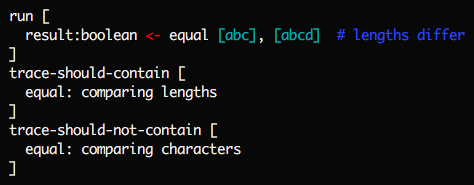
Another example: if a sort function logs each swap, a performance test can ensure that the number of swaps doesn't quadruple when the size of the input doubles.
Besides expanding the scope of tests, this ability also allows more radical refactoring without needing to modify tests. All Mu's tests call a top-level function rather than individual sub-systems directly. As a result the way the subsystems are invoked can be radically changed (interface changes, making synchronous functions asynchronous, etc.). As long as the new versions emit the same implementation-independent events in the logs, the tests will continue to pass. (More information.)
-
Organizing code and tests in layers of functionality, so that outsiders can build simple and successively more complex versions of a project, gradually enabling more peripheral features. Think of it as a cleaned-up
git logfor the project. (More information.)
Since I don't understand how Linux and other modern platforms work, Mu is built on an idealized VM while I learn. Eventually the plan is to transplant what I learn back to Linux.
To minimize my workload, Mu doesn't have a high-level language yet. Instead, I've been programming directly in the VM's idealized assembly language. I expected this to be painful, but it's had some surprising benefits. First, programs as lists of instructions seem to be easier for non-programmers to comprehend than programs as trees of expressions. Second, I've found that Literate Programming using layers makes assembly much more ergonomic. Third, labels for gotos turn out to be great waypoints to insert code at from future layers; when I tried to divide C programs into layers, I sometimes had to split statements in two so I could insert code between them.
High level languages today seem to provide three kinds of benefits: expressiveness (e.g. nested expressions, classes), safety (e.g. type checking) and automation (e.g. garbage collection). Mu gives up some expressiveness by not providing recursive expressions, but still supports lexical scope, generic types, and higher-order functions. It provides strong memory safety in spite of having manual memory management and supporting full-scale pointer operations (albeit at the cost of some runtime checks).
Taking Mu for a spin
Mu is currently implemented in C++ and requires a Unix-like environment. It's been tested on Ubuntu, Mac OS X and OpenBSD; on x86, x86_64 and ARMv7; and on recent versions of GCC and Clang. Since it uses no bleeding-edge language features and has no exotic dependencies, it should work with most reasonable versions, compilers or processors.
Running Mu will always recompile it if necessary:
$ cd mu
$ ./mu
As a simple example, here's a program with some arithmetic:

As I said before, Mu functions are lists of instructions, one to a line. Each instruction operates on some ingredients and returns some products.
[products] <- instruction [ingredients]
Result and ingredient reagents cannot contain instructions or infix expressions. On the other hand, you can have any number of them. In particular, you can have any number of products. For example, you can perform integer division as follows:
quotient:number, remainder:number <- divide-with-remainder 11, 3
Each reagent consists of a name and its type, separated by a colon. You only have to specify the type the first time you mention a name, but you can be more explicit if you choose. Types can be multiple words and even arbitrary trees, like:
x:array:number:3 # x is an array of 3 numbers
y:list:number # y is a list of numbers
# ':' is just syntactic sugar
{z: (map (address array character) (list number))} # map from string to list of numbers
Try out the program now:
$ ./mu example1.mu
$
Not much to see yet, since it doesn't print anything. To print the result, try
adding the instruction $print a to the function.
Here's a second example, of a function that can take ingredients:
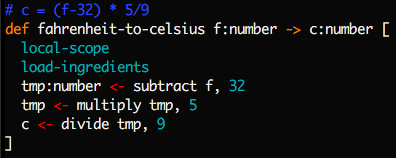
Functions can specify headers showing their expected ingredients and products,
separated by -> (unlike the <- in calls).
Once defined, functions can be called just like primitives. No need to mess
with a CALL instruction or push/pop arguments to the stack.
Since Mu is a low-level VM language, it provides extra control at the cost of
verbosity. Using local-scope, you have explicit control over stack frames to
isolate your functions in a type-safe manner. You can also create more
sophisticated setups like closures. One consequence of this extra control: you
have to explicitly load-ingredients after you set up the stack.
An alternative syntax is what the above example is converted to internally:
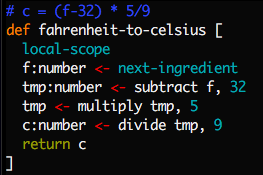
The header gets dropped after checking types at call-sites, and after
replacing load-ingredients with explicit instructions to load each
ingredient separately, and to explicitly return products to the caller. After
this translation functions are once again just lists of instructions.
This alternative syntax isn't just an implementation detail. I've actually found it easier to teach functions to non-programmers by starting with this syntax, so that they can visualize a pipe from caller to callee, and see the names of variables get translated one by one through the pipe.
A third example, this time illustrating conditionals:
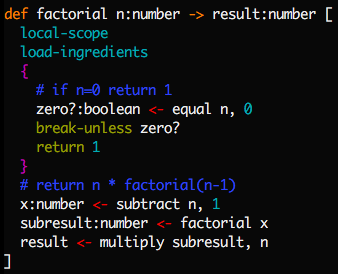
In spite of how it looks, this is still just a list of instructions and
labels. Internally, the instructions break and loop get converted to
jump instructions to after the enclosing } or { labels, respectively.
Try out the factorial program now:
$ ./mu factorial.mu
result: 120 # factorial of 5
You can also run its unit tests:
$ ./mu test factorial.mu
Here's what one of the tests inside factorial.mu looks like:
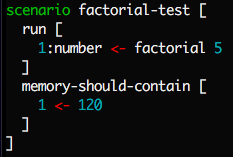
Every test conceptually spins up a really lightweight virtual machine, so you
can do things like check the value of specific locations in memory. You can
also print to screen and check that the screen contains what you expect at the
end of a test. For example, you've seen earlier how chessboard.mu checks the
initial position of a game of chess (delimiting the edges of the screen with
dots):

Similarly you can fake the keyboard to pretend someone typed something:
assume-keyboard [a2-a4]
As we add a file system, graphics, audio, network support and so on, we'll augment scenarios with corresponding abilities.
Mu assumes that all ingredients passed in to functions are immutable by default -- unless they are also products. So this program will throw an error:
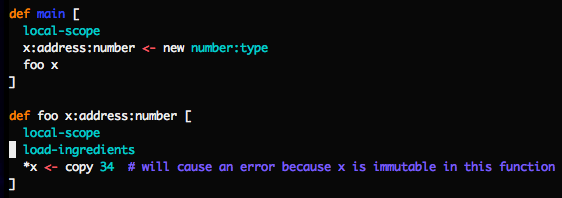
To modify foo's ingredient, you have to add it to the list of products
returned:

The names of the variables are important here: a function that takes an (immutable) address and returns a different one is different from a function that takes a mutable address (and also returns it).
Immutability checks can be annoying sometimes, but the benefit they provide is that you always know what a function modifies just by looking at its header. They provide all the benefits of referential transparency that we typically associate with (particularly purely functional) high-level languages -- but without giving up the flexibility to imperatively modify variables willy-nilly.
You can append arbitrary properties to reagents besides types and spaces. Just separate them with slashes.
x:array:number:3/uninitialized
y:string/tainted:yes
z:number/assign-once:true/assigned:false
Most properties are meaningless to Mu, and it'll silently skip them when running, but they are fodder for meta-programs to check or modify your programs, a task other languages typically hide from their programmers. For example, where other programmers are restricted to the checks their type system permits and forces them to use, you'll learn to create new checks that make sense for your specific program. If it makes sense to perform different checks in different parts of your program, you'll be able to do that.
You can imagine each reagent as a table, rows separated by slashes, columns within a row separated by colons. So the last example above would become something like this:
z : integer /
assign-once : true /
assigned : false
An alternative way to define factorial is by inserting labels and later inserting code at them.
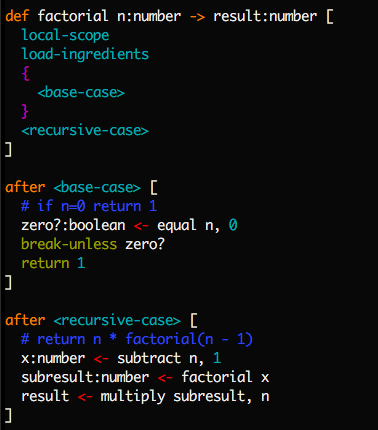
(You'll find this version in tangle.mu.)
By convention we use the prefix '+' to indicate function-local label names you can jump to, and surround in '<>' global label names for inserting code at.
Another example, this time with concurrency:

$ ./mu fork.mu
Notice that it repeatedly prints either '34' or '35' at random. Hit ctrl-c to stop.
Yet another example forks two 'routines' that communicate over a channel:
$ ./mu channel.mu
produce: 0
produce: 1
produce: 2
produce: 3
consume: 0
consume: 1
consume: 2
produce: 4
consume: 3
consume: 4
# The exact order above might shift over time, but you'll never see a number
# consumed before it's produced.
Channels are the unit of synchronization in Mu. Blocking on a channel is the only way for the OS to put a task to sleep. The plan is to do all I/O over channels.
Routines are expected to communicate purely by message passing, though nothing stops them from sharing memory since all routines share a common address space. However, idiomatic Mu will make it hard to accidentally read or clobber random memory locations. Bounds checking is baked deeply into the semantics, and pointers can never be invalidated.
Mu has a programming environment:
$ ./mu edit
Screenshot:

You write functions on the left and try them out in sandboxes on the right.
Hit F4 to rerun all sandboxes with the latest version of the code. More
details: http://akkartik.name/post/mu. Beware, it won't save your edits by
default. But if you create a sub-directory called lesson/ under mu/ it
will. If you turn that directory into a git repo with git init, it will also
back up your changes each time you hit F4. Use the provided new_lesson
script to take care of these details.
Once you have a sandbox you can click on its result to mark it as expected:

Later if the result changes it'll be flagged in red to draw your attention to it. Thus, manually tested sandboxes become reproducible automated tests.

Another feature: Clicking on the code in a sandbox expands its trace for you
to browse. To add to the trace, use stash. For example:
stash [first ingredient is], x
Invaluable for understanding complex control flow without cluttering up the screen.
If you're still reading, here are some more things to check out:
a) Look at the chessboard program for a more complex example where I write tests showing blocking reads from the keyboard and what gets printed to the screen -- things we don't typically associate with automated tests.
b) Try skimming the colorized source code. I'd like it to eventually be possible to get a pretty good sense for how things work just by skimming the files in order, skimming the top of each file and ignoring details lower down. Tell me how successful my efforts are.
c) Try running the tests:
$ ./mu test
The next major milestone on Mu's roadmap is dependency-injected interfaces for the network.
Credits
Mu builds on many ideas that have come before, especially:
- Peter Naur for articulating the paramount problem of programming: communicating a codebase to others;
- Christopher Alexander and Richard Gabriel for the intellectual tools for reasoning about the higher order design of a codebase;
- Unix and C for showing us how to co-evolve language and OS, and for teaching the (much maligned, misunderstood and underestimated) value of concise implementation in addition to a clean interface;
- Donald Knuth's literate programming for liberating "code for humans to read" from the tyranny of compiler order;
- David Parnas and others for highlighting the value of separating concerns and stepwise refinement;
- Lisp for showing the power of dynamic languages, late binding and providing the right primitives a la carte, especially lisp macros;
- The folklore of debugging by print and the trace facility in many lisp systems;
- Automated tests for showing the value of developing programs inside an elaborate harness;
- Python doctest for exemplifying interactive documentation that doubles as tests;
- ReStructuredText and its antecedents for showing that markup can be clean;
- BDD for challenging us all to write tests at a higher level;
- JavaScript and CSS for demonstrating the power of a DOM for complex structured documents.
- Rust for demonstrating that a system-programming language can be safe.